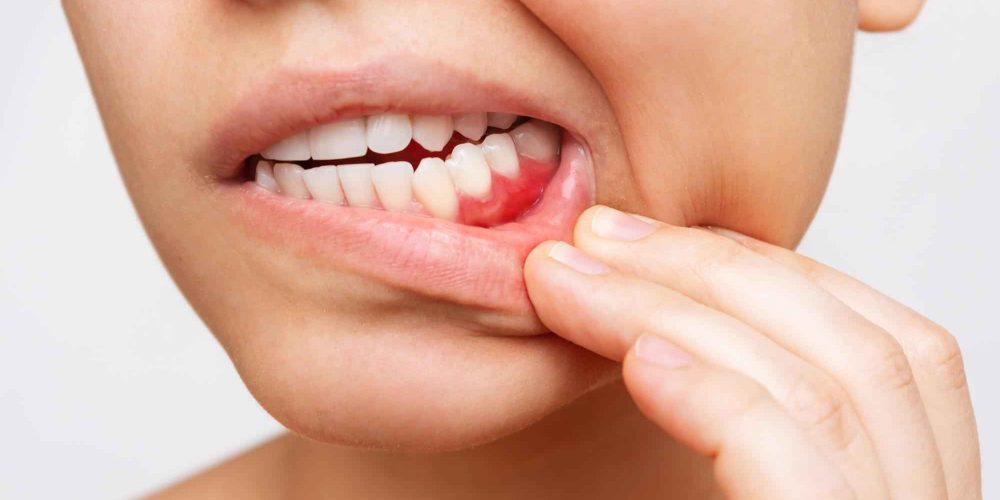Did you know that most Australian adults have gum disease? This oral health issue can start as mild gingivitis and progress to periodontitis. If not treated, it can lead to major tooth loss. We’ll look into the kinds of gum disease, what causes them and the treatments available to you to get your oral health back on track. These treatments help control the disease and stop it from getting worse.
Understanding Gum Disease
Gum disease comes in two main types: gingivitis and periodontitis. Gingivitis is the milder one, which we can reverse. It makes your gums red and sore. If you don’t treat gingivitis, it can turn into a worse type called periodontitis. Periodontitis can make your gums and bones around your teeth get worse, leading to tooth loss.
Types of Gum Disease
Gingivitis is quite common and not too severe. However, if it goes untreated, it can become periodontitis. This more serious gum disease can make you lose teeth and even the bone holding them.
Causes and Risk Factors
Not taking care of your teeth is the top reason for gum disease. Also, smoking, diabetes, some meds and even your genes can increase your risk for gum disease. Knowing and fixing these risks is key to fighting for the health of your smile.
Signs and Symptoms
Gum disease reveals itself with red, swollen, and tender gums, often bleeding when you brush or floss. You might have bad breath that doesn’t go away, gums that pull back from your teeth, and teeth that get sensitive. As it gets worse, your teeth might get loose and change position, which are serious signs of advanced gum disease. Spotting these signs early is crucial for stopping the disease.
Diagnosing Gum Disease
Your dentist will carefully check your mouth to see if you have gum disease. They start by looking at your teeth and talking about your health history. Then, they check your gums and bone. A small tool called a periodontal probe measures how deep the pockets are between your gums and teeth.
Periodontal Probing
Checking the pockets between your teeth and gums is very important. The dentist or hygienist will use a small, gentle tool to measure their depth. Healthy pockets are usually 1-3 millimetres deep. If the pockets are deeper, it could mean you have gum disease. Deeper pockets might mean it’s more advanced.
X-rays and Imaging
Your dentist might also take X-rays or use other imaging tests to check how much bone loss you have. Knowing this helps plan the best treatment for you.
Staging and Grading
After all the tests, your dentist will give your gum disease a stage and grade. The stage shows how serious it is, and the grade looks at your risk and treatment needs. This information helps make a plan just for you to get better.
Nonsurgical Treatments for Gum Disease

If you have the early stages of gum disease, like gingivitis, your first step might be a nonsurgical treatment. A dentist can clean your teeth professionally. This is called prophylaxis. It gets rid of plaque and tartar above and below the gumline. Routine cleanings, every six months, are key. They can turn around early gum disease and stop it from getting worse.
If your gum disease is more advanced, your dentist might suggest a deeper clean. This is known as scaling and root planing. It involves cleaning the teeth deeply, even under the gums. The procedure also makes the tooth roots smoother. This is to lower the chance of more bacteria sticking. You’ll likely get local anaesthesia to make the process more comfortable.
Your dentist could also give you antimicrobial treatments. These help deal with the bacterial infection in your gums. They may include using special mouthrinses, putting antibiotics directly into the gum pockets, or taking pills. These steps are meant to work with the physical cleaning, making the treatment even more effective.
Surgical Treatments for Gum Disease
If you have severe gum disease or it hasn’t improved with other treatments, you may need surgery. Flap surgery, or pocket reduction surgery, is one option. Your dentist or periodontist will make cuts in your gums to lift them back. This lets them clean out more plaque, tartar, and bad tissue. They might reshape the bone under the gums too, to stop bacteria. After cleaning and reshaping, they stitch your gums back down.
Bone Grafting
Gum disease can destroy the bone holding your teeth. Bone grafting helps rebuild this lost bone. The dentist will put tiny pieces of your bone, donated bone, or fake bone where it’s needed. This gives your body a start, helping it to regrow real bone. It makes your teeth stronger and stops more bone loss.
Soft Tissue Grafts
When gums pull away from teeth because of gum disease, it’s called gum recession. With soft tissue grafts, the dentist takes a bit of tissue, usually from your mouth’s roof, and moves it to the gum line. This makes the gum line stronger and covers up exposed tooth roots. It makes your smile look better, lowers tooth sensitivity, and keeps your gums from shrinking more.
Guided Tissue Regeneration
Guided tissue regeneration is for regrowing lost bone and other tissue from gum disease. The dentist will place a special membrane in your gum that stops fast-growing gum tissue. This lets slow-growing bone and tissue cells have a chance to grow. It helps your body rebuild what’s been lost around your teeth.
Lifestyle and Home Care for Gum Disease
It’s vital to look after your teeth at home to manage and stop gum disease from getting worse. You should brush your teeth in the morning and at night. Use a soft-bristled toothbrush and toothpaste with fluoride. Also, remember to floss every day. Doing these things the right way and every day helps remove plaque and food bits. These are what cause swollen gums and infections.
Proper Brushing and Flossing

Keeping your gums healthy means brushing and flossing well. It’s important to brush and floss your teeth two times a day. Plus, it’s a must to see your dentist regularly. This keeps gum disease away. Not looking after your teeth enough makes you more likely to have problems with your gums. Also, nearly all hard-to-treat cases happen in people who smoke.
About 90% of such cases involve smokers.
Quit Smoking
Stopping smoking helps your gums get better. It’s hard for your body to fight off gum disease if you smoke. This is because smoking weakens your immune system. Smokers have a bigger chance of getting gum disease. They also face a higher risk of dealing with severe gum problems that are hard to treat.
Diet and Nutrition
Eating well can also help your gums. Foods that are full of vitamins, minerals, and antioxidants are great. Think fruits, veggies, and lean meats. They help your body fight off gum disease and fix any damage. But, eating lots of sugary foods can make gum disease more likely. On the other hand, fruits and veggies with antioxidants can protect your gums.
A diet with plenty of fruits, veggies, proteins, and whole grains lowers your risks of gum disease. It also makes sure your gums stay healthy.
Take the First Step Towards Healthy Gums Today With Clyde North Dental
Most Australian adults suffer from gum disease, which can progress from mild gingivitis to severe periodontitis, leading to tooth loss if untreated. At Clyde North Dental, we offer comprehensive treatments to control and stop the progression of gum disease.
Contact us at 03 9121 8121 to schedule your consultation. Our team will diagnose your condition and tailor a treatment plan to restore and maintain your oral health. Don’t wait – your gums deserve the best care. Call Clyde North Dental now!

